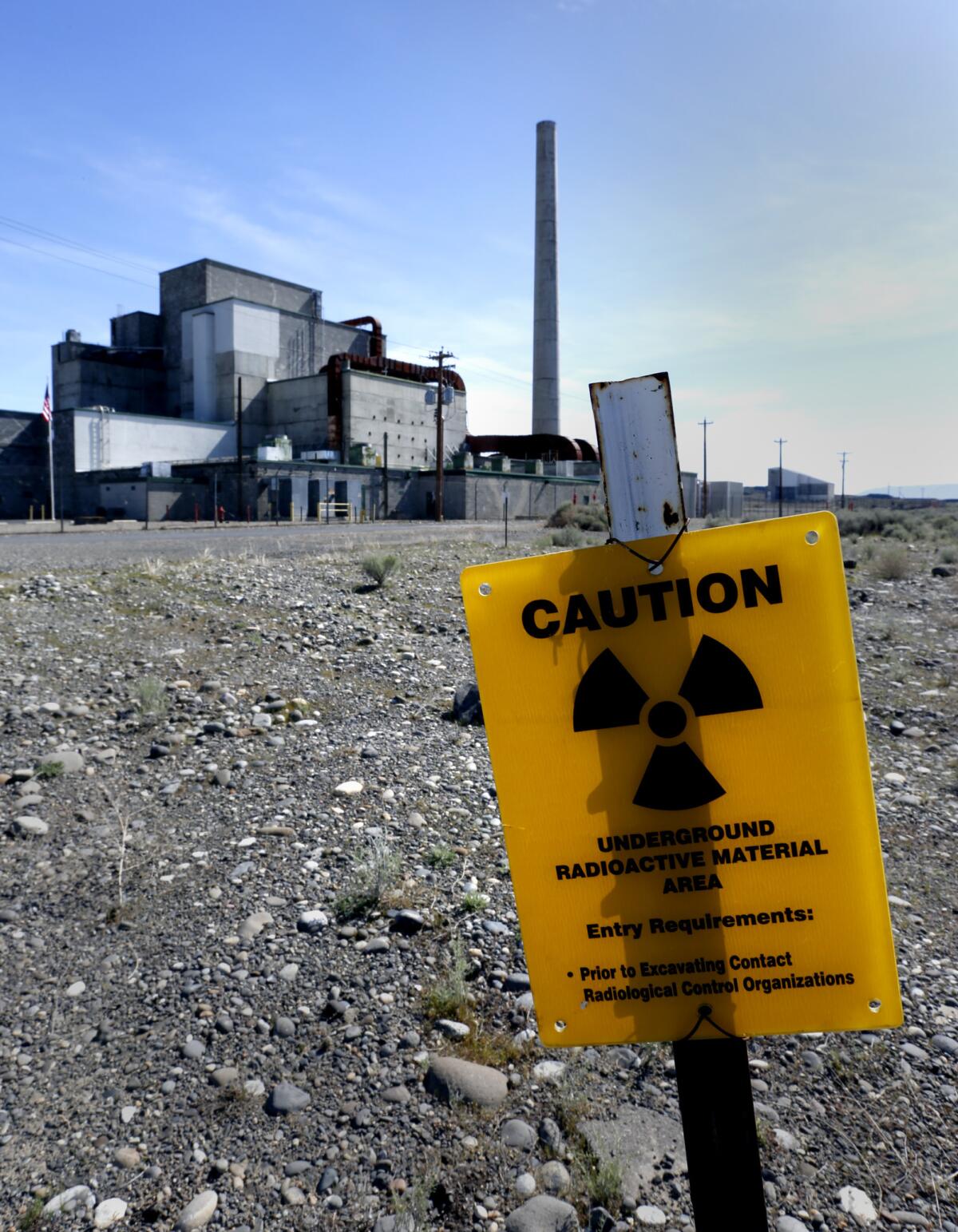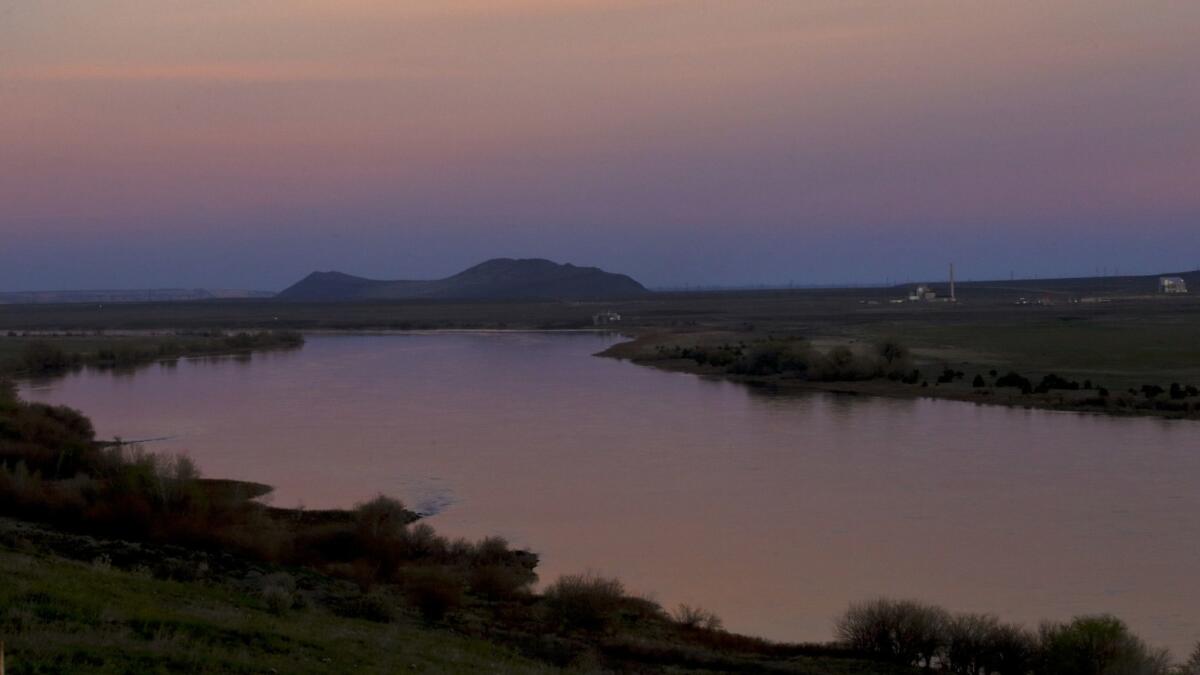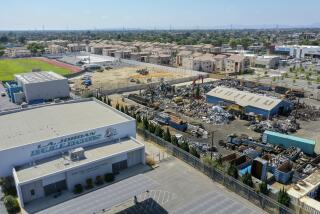Contamination from a nuclear cleanup forced a shutdown. Investigators want to know who is responsible
Reporting from Richland, Wash. — As crews demolished a shuttered nuclear weapons plant during 2017 in central Washington, specks of plutonium were swept up in high gusts and blown miles across a desert plateau above the Columbia River.
The releases at the Department of Energy cleanup site spewed unknown amounts of plutonium dust into the environment, coated private automobiles with the toxic heavy metal and dispensed lifetime internal radioactive doses to 42 workers.
For the record:
6:15 p.m. April 16, 2018An earlier version of this article said that work was stopped five years ago on a $16.8-billion waste treatment plant. Work did stop on key parts of the plant, but there were portions that continued to operate.
The contamination events went on for nearly 12 months, getting progressively worse before the project was halted in mid-December. Now, state health and environmental regulators, Energy Department officials and federal safety investigators are trying to figure out what went wrong and who is responsible.

The events at the Hanford Site, near the Tri-Cities area of Richland, Pasco and Kennewick, vividly demonstrate the consequences when a radioactive cleanup project spirals out of control. The mess has dealt the Department of Energy’s nuclear weapons environmental management program yet another setback, following more than a decade of engineering miscalculations across the nation.
Energy Department officials said in a statement that workers received only a tiny fraction of the plutonium exposure that is allowed by regulations, and there should be no threat to their health. They declined requests for interviews.
If the current investigations substantiate that statement, it would be fortuitous.
“They are not in control,” John Martell, the Washington Department of Health official who oversees radioactive air emissions, said about the Energy Department and its contractors. “We want them to stop before they do become a public health threat.”
Tom Carpenter, executive director of the watchdog group Hanford Challenge, asserts that the demolition project used too many unskilled workers, attempted to do the work too fast and failed to adopt known safety measures that would have helped contain the contamination.
“They took shortcuts and stupid risks,” Carpenter said. “They gambled and lost.”
The mishap occurred at one of the nation’s most radioactively contaminated buildings, known as the Plutonium Finishing Plant. The factory, which opened in 1949 a few miles from the Columbia River, supplied plutonium for thousands of U.S. nuclear weapons before it was shut down in 1989. It was the notorious site where Harold McCluskey, later known as the Atomic Man, survived a 1976 explosion in which he was exposed to 500 times the occupational limit for radioactivity.
The exposures from the plutonium releases last year were minuscule by comparison, estimated to be a small fraction of the background radiation that every human gets from nature. But unlike cosmic radiation or radon gas, plutonium can lodge itself inside the body and deliver tissue damaging alpha particles over a lifetime.
Union officials say they can accept the health risk of working next to contaminated equipment, but not an “uptake” of plutonium when eating lunch or driving home in a car after protective gear is off.
“It is very upsetting because they don’t [care],” said one exposed worker who would speak only on condition of anonymity out of fear of retaliation. He said he was not given a kit to test for plutonium exposure until he asked for one in early December.
“They have no clue how I was exposed,” he said. “I look at it down the road and am mentally worried about it. It is emitting energy into my bones. Plus it is a poison. My wife is worried. My kids listen to the news and know what happened. I have to put it off in front of them as no big deal.”
The price tag for cleaning up nuclear waste at Hanford site just went up another $4.5 billion »
In their statement, Energy Department officials said they are “concerned about any health consequences, long-term or short-term, that any of the workers on site face at any time. We are addressing workers’ concerns by being as open and transparent with our workers as possible about what we are doing to stabilize the situation.”
Another longtime employee at the Plutonium Finishing Plant, or PFP, who met with a Times reporter, said the operation was out of control even before the demolition began. As workers removed equipment to prepare for walls to be torn down, air monitoring alarms sounded almost every day, he said. Workers were subjected to repeated nasal smears to determine if they had breathed plutonium dust, he said.
“Nobody wanted to work at PFP,” he said. “People who had been working at Hanford for 30 years were getting out, saying this is insane.”
And as the project fell behind schedule, many of the workers were compelled to put in as many as 90 hours a week, he said.
“Everything we were told to do at work began to deviate from the plan,” he said.
Seven employee automobiles were contaminated at the plant site, according to a Jan. 9 letter from the state Department of Ecology to Doug Shoop, the federal site chief at Hanford. When one worker demanded that his contaminated car be purchased because vent ducts were potentially still contaminated, Energy Department contractors nixed it and offered him a coupon for a free detailing from a car wash, according to collective bargaining grievance records cited by union officials. The account was confirmed by two other employees.
An even more serious concern was the potential for the workers to have contaminated their homes after leaving work. The Energy Department dispatched teams to take samples in eight private homes and found no contamination, a Hanford Site spokesman said in a statement.
The demolition, costing $57 million, was being conducted by one of the nation’s largest engineering firms, CH2M, a unit of Texas-based Jacobs Engineering. CH2M is now under federal investigation for the releases, according to a letter sent by the Energy Department’s enforcement office in late March.
A spokesman for the company declined to comment and referred questions to the Energy Department’s Hanford Site office. In March, the company released a preliminary analysis of the contamination and blamed it on a half dozen factors, including a “fixative” that was supposed to bind the dust but was too diluted to work properly and a decision to accelerate demolition when the contamination seemed to be stable.
The Energy Department plan for the demolition originally required the contractor to remove debris as it accumulated. But in January 2017, just before the first releases, officials authorized CH2M to allow the debris to pile up, according to a monthly site report by an inspector for the Defense Nuclear Facilities Safety Board, an independent agency.
In fact, workers at the plant said the demolition site was ringed by 8-foot-tall piles of radioactive debris with little to prevent dust from blowing off.
Not long after, the first plutonium was detected. Another series of dispersals occurred in June, which resulted in a short work stoppage. The workers at the plant said radiation alarms sounded throughout the facility, resulting in a chaotic mass evacuation. And then in December, a three-day series of dispersals was recorded and became the basis for what is now a four-month shutdown of the project.
“December was the most serious,” said Martell, the Health Department chief for radioactive air emissions. “Part of the reason we issued the letter was that events were growing in seriousness. The December event was the trigger.”
Alex Smith, who oversees the Hanford Site for the state Department of Ecology and shares oversight responsibility with the state Department of Health, said the decision to allow debris to accumulate probably increased the risk that winds could transport the dust. Plutonium was detected by monitors and collection plates about two miles away, near a public road, and potentially 10 miles away.
Washington’s two senators sent a letter to the Energy Department on Dec. 22, expressing “grave concern” about the releases. Congressional staff say the contamination is not surprising because the Energy Department offers bonuses to contractors if they meet tight schedules. But there are no bonuses for preventing worker contamination or preventing releases to the environment, they say.
The problems at the Plutonium Finishing Plant were not an isolated event at Hanford, which has struggled with its cleanup for more than a decade.
Work was stopped five years ago on key parts of a $16.8-billion waste treatment plant that is supposed to turn 56 million gallons of radioactive sludge into glass. Technical deficiencies in its design are still being studied, while delays mount. Several years ago, the Energy Department pushed back the full startup by 17 years to 2039, though it hopes to begin treating some less radioactive waste by 2022.
Last year, a tunnel that stored railroad cars full of contaminated equipment collapsed. The Energy Department pumped the 358-foot long tunnel full of a concrete mixture. A decision is pending about what to do with a second storage tunnel 1,688 feet long.
The state attorney general, along with Hanford Challenge and a union, is suing the Energy Department for venting noxious gases from underground waste tanks over recent years, sickening workers.
Smith, the Ecology manager, said a lot of cleanup progress has been made at Hanford. Hundreds of buildings have been torn down. Much of the soil along the banks of the Columbia River has been cleaned up enough for any future use. And the site’s nine nuclear reactors have been put in stable condition.

But the well-publicized problems have put state officials on edge about contamination that would affect public health. One of factors that helped reduce the risks of the release is the relative isolation of the Plutonium Finishing Plant, which is deep inside the 586-square-mile Hanford Site. But other contaminated facilities scheduled for demolition border the Columbia River and are close to residential communities and fields that grow grapes, potatoes and corn.
One of those facilities, known as 324 Building, was used to extract plutonium from spent fuel, said Robert Alvarez, a former assistant secretary of Energy and a longtime critic of the cleanup. The facility has civilian waste from Germany, sent as part of a research project, as well as large amounts of radioactive waste that was placed in unlined burial pits, he said. Records of what lies in the pits were destroyed in 1988, he said.
When the demolition of the Plutonium Finishing Plant will resume is unclear, along with who can authorize it. In a statement to The Times, Energy Department Press Secretary Shaylyn Hynes said, “The decision to stop work at the site was made on site by the contractor.” But letters by state health, ecology and U.S. Environmental Protection Administration officials over the last several months indicate they issued a stop-work order that applies until they determine that the work can be conducted safely.
The Energy Department statement said it opted to demolish the plant in “open air,” because it is a proven safe method. But now, the statement said, it is looking for lessons learned from the releases. State officials, meanwhile, are asking for additional safety measures, potentially a temporary tent or other structure over the plant.
John A. Christian, a veteran of nuclear demolition projects at EnergySolutions who was not involved in the Plutonium Finishing Plant demolition, said such containment structures have been used at the cleanup of the Energy Department’s Rocky Flats plant in Colorado and at an Idaho National Laboratory site.
“In the most extreme circumstance,” he said, “you put a building over the building. All of the dust and debris is contained inside and it is removed through an air lock.”
Follow me on Twitter @rvartabedian
More to Read
Sign up for Essential California
The most important California stories and recommendations in your inbox every morning.
You may occasionally receive promotional content from the Los Angeles Times.











